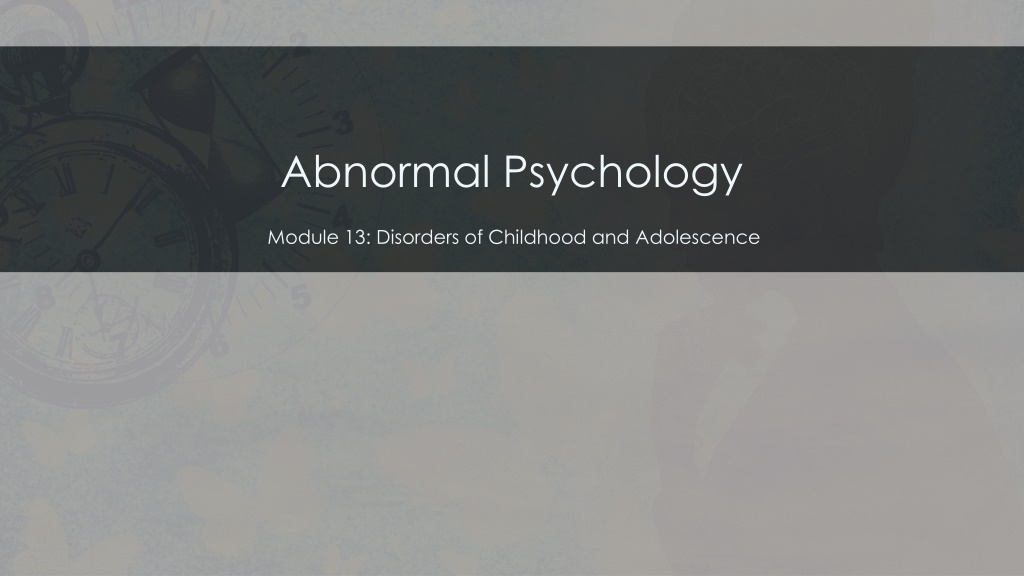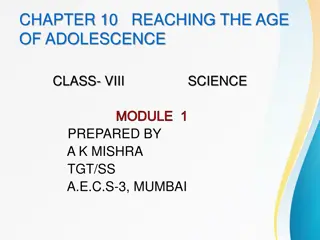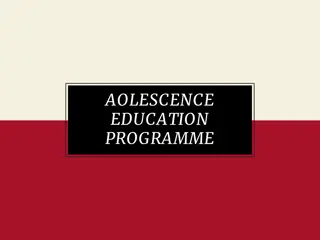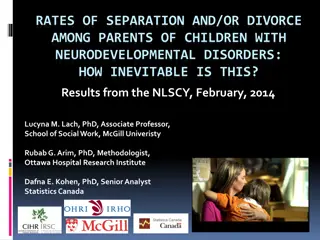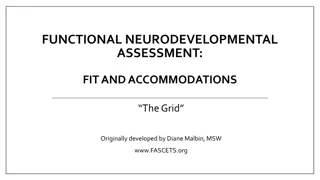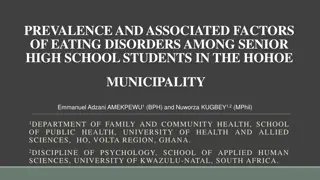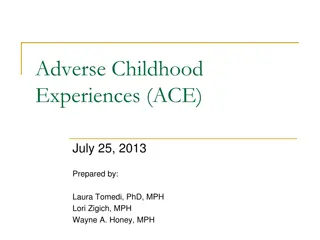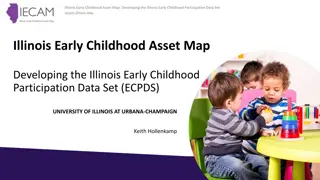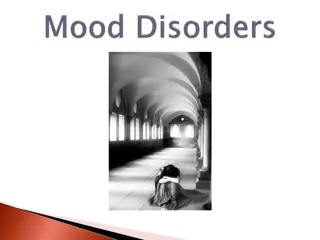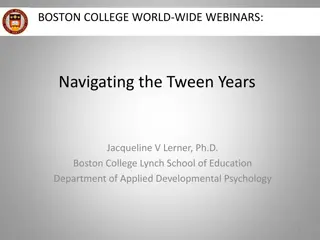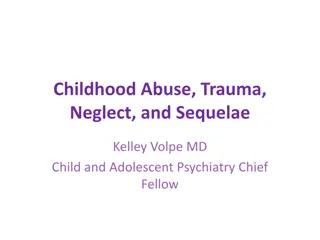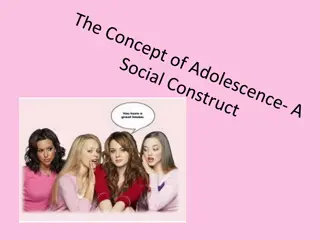Understanding Neurodevelopmental Disorders in Childhood and Adolescence
Neurodevelopmental disorders in childhood and adolescence encompass a range of conditions including intellectual disabilities, communication disorders, autism spectrum disorder, and attention deficit/hyperactivity disorder. These disorders impact cognitive development, adaptive functioning, and communication skills. Intelligence testing plays a crucial role in identifying cognitive delays and guiding appropriate interventions for children with these disorders. Intellectual disabilities, characterized by impaired intellectual and adaptive functioning, affect a significant percentage of the population. Early diagnosis and tailored interventions are vital for supporting individuals with neurodevelopmental challenges.
- Neurodevelopmental Disorders
- Childhood
- Adolescence
- Intellectual Disabilities
- Communication Disorders
Download Presentation

Please find below an Image/Link to download the presentation.
The content on the website is provided AS IS for your information and personal use only. It may not be sold, licensed, or shared on other websites without obtaining consent from the author. Download presentation by click this link. If you encounter any issues during the download, it is possible that the publisher has removed the file from their server.
E N D
Presentation Transcript
Abnormal Psychology Module 13: Disorders of Childhood and Adolescence
Module Learning Outcomes Examine Disorders of Childhood and Adolescence 13.1: Examine and explain neurodevelopmental disorders 13.2: Examine and explain disruptive, impulse-control, and conduct disorders 13.3: Examine psychological approaches and treatments related to childhood disorders
Understanding Neurodevelopmental Disorders 13.1: Examine and explain neurodevelopmental disorders 13.1.1: Describe intelligence and how it is measured 13.1.2: Explain diagnostic criteria for intellectual disabilities 13.1.3: Describe common causes of intellectual disability, including fetal alcohol syndrome, Down syndrome, and fragile X syndrome 13.1.4: Examine the management and treatment of intellectual developmental disorders 13.1.5: Describe the diagnosis and presentation of communication disorders (language disorder, speech sound disorder, childhood-onset fluency disorder, social (pragmatic) communication disorder) 13.1.6: Differentiate between communication disorders 13.1.7: Describe the symptoms, risk factors, influences, and prevalence of autism spectrum disorder 13.1.8: Describe the symptoms, risk factors, influences, and prevalence of attention deficit/hyperactivity disorder 13.1.9: Describe the characteristics and diagnosis of specific learning disorders
Measuring Intelligence Intelligence: a wide range of mental activities such as the ability of logical reasoning and practical intelligence (problem-solving), ability in learning, verbal skills, and so on. Intelligence quotient (IQ), which represents a total score obtained from standardized tests (IQ tests) developed for evaluating human intelligence. A score of 70 or below indicates significant cognitive delays, major deficits in adaptive functioning. Children who seem to be experiencing learning difficulties or severe behavioral problems can be tested to ascertain whether the child s difficulties can be partly attributed to an IQ score that is significantly different from the mean for her age group.
Intellectual Disabilities Intellectual development disorder, also called intellectual disability (ID) or a general learning disability, is a generalized neurodevelopmental disorder characterized by significantly impaired intellectual and adaptive functioning. Three criteria must be met for a diagnosis of intellectual development disorder: Significant limitation in general mental abilities (intellectual functioning), Significant limitations in one or more areas of adaptive behavior across multiple environments (as measured by an adaptive behavior rating scale, i.e. communication, self-help skills, interpersonal skills, and more) Evidence that the limitations became apparent in childhood or adolescence. Syndromic intellectual development disorder: intellectual deficits associated with other medical and behavioral signs and symptoms are present Non-syndromic intellectual development disorder: intellectual deficits appear without other abnormalities. Intellectual development disorder affects about 2 3% of the general population, of which seventy-five to ninety percent of the affected people have mild intellectual disability.
Causes of Intellectual Development Disorders The etiology of intellectual development disorder can be divided into genetic abnormalities and environmental exposure. Genetic abnormality may cause an inborn error of metabolism neurodevelopmental defect, or neurodegeneration. Environmental exposure during pregnancy may lead to intellectual development disorder, which can be caused by maternal exposure to a toxin, infectious agent, uncontrolled maternal condition, and birth complications. Fetal alcohol syndrome: most common, known preventable or environmental cause of intellectual development disorder Down syndrome: most common chromosomal cause Fragile X syndrome: most common genetic cause
Treatment of Intellectual Developmental Disorders Management of intellectual development disorder must begin promptly with the goals to prevent further worsening, minimize the symptoms of disability, and improve the quality of everyday life. Behavioral therapy aims to encourage positive behaviors while discouraging undesirable behaviors. Vocational training helps teenagers and young adults to obtain the necessary skills to enter the labor market. Family education is an essential service provided by healthcare providers for family members of intellectually disabled patients. Psychopharmacologic interventions may not be the main component of intellectual development disorder treatment, but they play a significant role in treating behavioral abnormalities associated with intellectual disorder and comorbid conditions.
Communication Disorders A communication disorder is any disorder that affects an individual's ability to comprehend, detect, or apply language and speech to engage in discourse effectively with others. Language disorder: the important characteristics of a language disorder are difficulties in learning and using language, which is caused by problems with vocabulary, with grammar, and with putting sentences together in a proper manner. Speech sound disorder: previously called phonological disorder, for those with problems with pronunciation and articulation of their native language. Childhood-onset fluency disorder (stuttering): standard fluency and rhythm of speech is interrupted, often causing the repetition of whole words and syllables Social (pragmatic) communication disorder: this diagnosis describes difficulties in the social uses of verbal and nonverbal communication in naturalistic contexts, which affect the development of social relationships and discourse comprehension. Unspecified communication disorder: for those who have symptoms of a communication disorder but do not meet all criteria, and whose symptoms cause distress or impairment.
Differentiate Between Communication Disorders Language disorder: difficulties in learning and using language. Speech sound disorder: pronunciation and articulation of their native language Childhood-onset fluency disorder (stuttering): standard fluency and rhythm of speech is interrupted Social (pragmatic) communication disorder: difficulties in the social uses of verbal and nonverbal communication
Class Activity: Autism Group Discussion In a group, discuss any depictions of autism you have seen on TV or in movies. Can you think of examples where these characters have been portrayed in a positive light? What characteristics of autism were shown? How does the concept of neurodiversity help us to see autism spectrum disorders, or other mental disorders, in a different light?
Autism Spectrum Disorder Autism spectrum disorder is probably the most misunderstood and puzzling of neurodevelopmental disorders. Children with this disorder show signs of significant disturbances in three main areas: (a) deficits in social interaction (b) deficits in communication (c) repetitive patterns of behavior or interests. Center for Disease Control and Prevention s Autism and Developmental Disabilities Monitoring Network indicate that 1 in 59 children in the United States has autism spectrum disorder; the disorder is 4 times more common among boys (1 in 38) than in girls (1 in 152) Autism appears to be strongly influenced by genetics, as identical twins show concordance rates of 60% 90%, whereas concordance rates for fraternal twins and siblings are 5% 10%
ADHD Diagnosis in Children How is ADHD in children tested and treated? A paediatrician at Mediclinic explains how they diagnose children of school-going age with ADHD by first excluding all other possible causes of ADHD symptoms. She explains when medication is considered and what other treatments are helpful.
Attention Deficit/Hyperactivity Disorder Attention deficit/hyperactivity disorder (ADHD): a constant pattern of inattention and/or hyperactive and impulsive behavior that interferes with normal functioning. The diagnostic criterion includes: great difficulty with and avoidance of tasks that require sustained attention (such as conversations or reading) failure to follow instructions (often resulting in failure to complete school work and other duties), disorganization (difficulty keeping things in order, poor time management, sloppy and messy work) lack of attention to detail becoming easily distracted forgetfulness ADHD occurs in about 5% of children. On average, boys are 3 times more likely to have ADHD than are girls.
Specific Learning Disorders Specific learning disorder is a classification of disorders in which a person has difficulty learning in a typical manner within one of several domains. Dyslexia: the most common learning disability of all students with specific learning disabilities, 70% 80% have deficits in reading. Dyscalculia: a form of math-related disability that involves difficulties with learning math-related concepts, memorizing math-related facts, organizing numbers, and understanding how problems are organized on the page. Dysgraphia: typically show multiple writing-related deficiencies, such as grammatical and punctuation errors within sentences, poor paragraph organization, multiple spelling errors, and excessively poor penmanship.
Practice Question 1 Henry is in sixth grade and has trouble with math. He was first taught math in the second grade but still has issues adding and subtracting. Henry has trouble adding in his head and even on paper. Henry asked his teacher for extra help as he was having trouble adding 11+15, and he was later diagnosed with a learning disability. Which one of the following would likely be Henry s diagnosis? A. Dyslexia B. Dyscalculia C. Dysgraphia D. Dysfunction
Disruptive, Impulse-Control and Conduct Disorders
Disruptive, Impulse-Control, and Conduct Disorders 13.2: Examine and explain disruptive, impulse-control, and conduct disorders 13.2.1: Describe the characteristics and etiology of conduct disorders 13.2.2: Describe the characteristics, etiology, and treatment of oppositional defiant disorder 13.2.3: Describe the characteristics and etiology of motor disorders (developmental coordination disorder, stereotypic movement disorder, Tourette's Disorder, persistent (chronic) motor or vocal tic disorder, and provisional tic disorder) 13.2.4: Describe elimination disorders and how they are treated
Conduct Disorders Conduct disorder (CD) is a mental disorder diagnosed in childhood or adolescence that presents itself through a repetitive and persistent pattern of behavior in which the basic rights of others or major age-appropriate norms are violated. The four main groups of symptoms are described below: Aggression to people and animals Destruction of property Deceitfulness or theft Serious violations of rules
Oppositional Defiant Disorder What Is Oppositional Defiant Disorder? Oppositional defiant disorder is a condition marked by overt aggressiveness, hostility, and disobedience. People with ODD purposefully bother and irritate others; their behavior goes beyond "irritable." Some studies estimate that as many as 65 percent of kids with ADHD also have symptoms of ODD. Could yours? Learn more about the condition here: https://www.additudemag.com/category/understand-conditions/related-conditions/oppositional-defiant-disorder/ Related Resources: 1. Self-Test: ODD in Children: https://www.additudemag.com/screener-oppositional-defiant-disorder-symptoms-test-children/ 2. Self-Test: ODD in Adults: https://www.additudemag.com/screener-oppositional-defiant-disorder-symptoms-test-adults/ 3. Download: Does My Child Have Oppositional Defiant Disorder? https://www.additudemag.com/download/does-my-child-have-odd/ 4. Download: The 15-Day Fix for Defiant Behavior: https://www.additudemag.com/download/adhd-defiant-behavior-fix-for-parents/ Subscribe to the ADDitude YouTube Channel: https://www.youtube.com/channel/UC_3d1NVczqxa-cQzFt2iVSw Visit the ADDitude web site: https://www.additudemag.com Follow ADDitude on Facebook: https://www.facebook.com/additudemag/ Follow ADDitude on Instagram: https://www.instagram.com/additudemag/ Follow ADDitude on Twitter: https://www.twitter.com/ADDitudeMag/
Oppositional Defiant Disorders Oppositional defiant disorder (ODD): is listed in the DSM-5 under disruptive, impulse-control, and conduct disorders and defined as "a pattern of angry/irritable mood, argumentative/defiant behavior, or vindictiveness" in children and adolescents. Symptoms include: Frequent loss of temper Touchiness or being easily annoyed Anger and resentfulness Arguing with authority figures or for children and adolescents, with adults Defying or refusing to comply with requests from authority figures or rules Deliberately annoying others Blaming others for their mistakes or misbehavior Being spiteful or vindictive at least twice within the past 6 months
Motor Disorders Motor disorders are malfunctions of the nervous system that cause involuntary or uncontrollable movements or actions of the body. Developmental coordination disorder (DCD), is a chronic neurological disorder beginning in childhood. Stereotyped movements are common in infants and young children Tourette s syndrome is a common neurodevelopmental disorder that begins in childhood or adolescence. It is characterized by multiple movement (motor) tics and at least one vocal (phonic) tic. Persistent tic disorder: have one or more motor tics or vocal tics, but not both, have tics that occur many times a day nearly every day or on and off throughout a period of more than a year, have tics that start before age 18 years, have symptoms that are not due to taking medicine or other drugs, or due to having a medical condition that can cause tics, and not have been diagnosed with TS. Provisional tic disorder: have one or more motor tics or vocal tics, have been present for no longer than 12 months in a row, have tics that start before age 18 years, have symptoms that are not due to taking medicine or other drugs, or due to having a medical condition that can cause tics, and not have been diagnosed with TS or persistent motor or vocal tic disorder.
Elimination Disorders Enuresis is defined as voiding of urine into bed/clothing, in children who are at least five years of age. Diagnostic criteria: Repeated voiding of urine into bed or clothes Behavior must be clinically significant as manifested by either a frequency of twice a week for at least three consecutive weeks or the presence of clinically significant distress or impairment in social, academic, or other important areas of functioning. Chronological or developmental age is at least 5 years of age The behavior is not due exclusively to the direct physiological effect of a substance or a general medical condition Encopresis involves either voluntary or involuntary voiding of the bowels in inappropriate places, in children who are at least four years of age. Diagnostic criteria: Repeated passage of feces into inappropriate places At least one such event a month for at least 3 months Chronological age of at least 4 years The behavior is not exclusively due to a physiological effect of a substance or a general medical condition, except through a mechanism involving constipation.
Practice Question 2 Eva is four years old and, for about a year now, has been acting out more and more. She is angry much of the time and gets easily annoyed by things at home and at school. Eva argues with her parents about everything, especially when she is in trouble. Eva enjoys deliberately annoying others and has been vindictive four times in the last nine months. What diagnosis might apply to Eva? A. Conduct Disorder B. Oppositional Defiant Disorder C. Motor Disorders D. Elimination Disorders
Perspectives and Treatments of Childhood Disorders
Understanding Perspectives and Treatments of Childhood Disorders 13.3: Examine psychological approaches and treatments related to childhood disorders 13.3.1: Describe and compare viewpoints from the major psychological perspectives related to childhood disorders 13.3.2: Examine and compare treatments for neurodevelopmental disorders
Perspectives on Childhood Disorders Biological: types of disorders that would fall in line with the biological perspective would be: Down's syndrome and Fragile X syndrome, motor disorders, and it is believed that various genes and gene mutations may be an underlying cause for autism. Sociocultural: views a person's behaviors and/or symptoms in light of their culture and background. Psychodynamic: disorders that could possibly be viewed as being "stuck" in the "id" could be conduct disorders since these involve more primitive drives and urges of "acting out" versus trying to live up to standards of "right" and "wrong" within socially acceptable norms. Humanistic: rejects the idea of biological determinism that regardless of nature, nurture has more influence in determining the potential outcomes of one's life. Cognitive: focuses on studying our thoughts and their relationship to our experiences and our actions. Behavioral: If someone is conditioned to act or react a certain way, this could lead to the diagnosis of certain disorders.
Treatments for Neurodevelopmental Disorders Autism: Early behavioral interventions or speech therapy can help children with autism gain self-care, social, and communication skills. ADHD: Management recommendations vary by country and usually involve some combination of counseling, lifestyle changes, and medications. Learning Disabilities: Various interventions can improve outcomes for children and often these can resolve on their on as children age. Communication Disorders: Treatments are usually carried out by speech and language therapists/pathologists, and/or audiologist, who use a wide range of techniques to stimulate language learning. Motor Disorders: Treatments utilize knowledge, education, and understanding which are uppermost in management plans for these disorders, and psychoeducation is the first step. Intellectual Development Disorders: Treatment involves active participation from caregivers, community members, clinicians, and of course, the individual(s) with an intellectual development disorder (intellectual disability).
Practice Question 3 Patrick is ten years old and was recently diagnosed with ODD. Patrick s therapist feels that he is acting out because he does not want to live up to what is right and wrong. Patrick s therapist s background on the subject would be associated with which perspective? A. Biological B. Sociocultural C. Psychodynamic D. Behavioral
Case Study: ADHD Connor: Connor is ten years old and was diagnosed with ADHD when he was five. When he was eight, he started taking 14 medications and 2 ADHD medications. Connor, due to being on two ADHD meds, was not overly hungry, so as part of the prescriptions he was on an appetite stimulant. Connor also had trouble with his digestive system and had bathroom issues at times. Connor s teacher recently felt that he should have his medication dosage increased, so he went to the doctor. Connor s doctor asked why he is not focused in his teacher s class, and he said it was because she was really boring and was not as exciting and fun as his other teachers. Connor s doctor did not increase the dosage on one of the ADHD meds.
